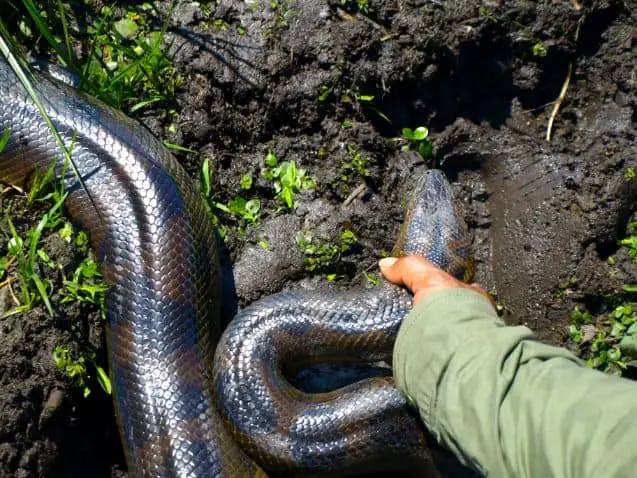How Do Snakes See at Night?
Ever wondered how snakes navigate and hunt in the dark? It may seem impossible, but certain snake species possess an extraordinary ability to see in total darkness.
Pit vipers, boa constrictors, and pythons, in particular, have developed exceptional prey detection skills that allow them to locate targets even without light.
In a recent study led by Pradeep Sharma, researchers have made significant progress in explaining this fascinating process.
By studying the cells within the pit organ, they’ve discovered that these cells function as a pyroelectric material, enabling snakes to convert heat into electrical signals.
Key Takeaways
- Certain snake species like pit vipers, boa constrictors, and pythons can see in total darkness.
- The ability to detect prey in the dark is linked to the pit organ, which acts as an antenna to detect infrared radiation.
- The cells in the pit organ have pyroelectric properties, allowing them to generate an electric charge in response to mechanical stress.
- The pit organ processes the infrared radiation emitted by warmer organisms or objects to form a thermal image, enabling snakes to detect small temperature variations.
Snake Vision in the Dark: A Natural Phenomenon
Snakes with a pit organ can detect small temperature variations, allowing them to see in the dark by processing infrared radiation into thermal images.
This is a remarkable adaptation in snake vision, enabling them to navigate and locate prey even in complete darkness.
The pit organ, found in species like pit vipers, boa constrictors, and pythons, acts as an infrared radiation detector.
It’s a hollow chamber enclosed by a thin membrane, and its cells have pyroelectric properties. When warmer organisms or objects emit infrared radiation, the pit organ detects it and converts it into a thermal image.
This incredible thermal imaging capability is a natural phenomenon that allows snakes to thrive in environments where sight alone would be insufficient.
The snake’s ability to adapt and utilize thermal imaging demonstrates the remarkable diversity of vision in the animal kingdom.
The Pit Organ: An Infrared Detection System
The pit organ, found in certain snake species, serves as an infrared detection system. It’s a hollow chamber enclosed by a thin membrane that can detect small temperature variations.
The pit organ acts as an antenna, processing infrared radiation emitted by warmer organisms or objects to form a thermal image.
Pit Organ Function Explained
You can understand how the pit organ functions as an infrared radiation detector.
The pit organ is a hollow chamber enclosed by a thin membrane. Snakes with a pit organ can detect small temperature variations.
The pit organ acts as an infrared radiation detector, picking up infrared radiation emitted by warmer organisms or objects. This ability is crucial for snakes to locate prey in the dark.
The pit organ processes the infrared radiation to form a thermal image, allowing the snake to accurately detect the heat signature of its prey. This remarkable feature has evolved over time, providing snakes with an advantage in hunting.
Understanding the pit organ’s function has also influenced the development of thermal imaging technology, which utilizes similar principles to detect and visualize heat signatures in a wide range of applications.
Role of TRPA1 Proteins?
To better understand the role of TRPA1 proteins, researchers are conducting further studies to establish a connection between the proposed mechanism and these proteins.
Function of TRPA1 proteins:
- TRPA1 proteins are ion channels found in the cells of the pit organ.
- These proteins play a crucial role in detecting and processing sensory information.
Role of ion channels:
- Ion channels are essential for the transmission of electrical signals in cells.
- TRPA1 proteins act as ion channels in the pit organ cells.
- They allow the flow of ions, such as calcium and sodium, into and out of the cells.
- This ion movement is vital for generating electrical signals in response to thermal stimuli.
Understanding the function of TRPA1 proteins and their role as ion channels is crucial in unraveling the intricate process of snake vision in the dark.
Further research will shed light on the specific mechanisms by which these proteins contribute to the ability of snakes to detect prey in low-light conditions.
Pyroelectric Materials: Unraveling the Snake’s Secret
Pyroelectric materials, which generate an electric charge in response to mechanical stress, play a crucial role in unraveling the snake’s secret of how they see at night.
Through modeling techniques and studying electrical charge generation, scientists have discovered that certain snake species possess a unique ability to detect prey in total darkness.
The key lies in the pit organ, a hollow chamber enclosed by a thin membrane. This organ acts as an antenna, detecting infrared radiation emitted by warmer organisms or objects.
The cells within the pit organ membrane exhibit pyroelectric properties, allowing them to convert heat into electrical signals. This process enables the snake to form a thermal image, providing them with exceptional prey detection skills in the dark.
While questions still remain regarding the role of TRPA1 proteins and ion channels, this research sheds light on the fascinating mechanism behind snake vision at night.
Mechanism Explanation: Cells With Pyroelectric Properties
The cells within the pit organ membrane, acting as a pyroelectric material, explain how snakes can detect prey in total darkness. These cells have pyroelectric properties, allowing them to generate an electric charge in response to mechanical stress.
This mechanism enables the cells to convert heat from warmer organisms into electrical signals, providing the snake with the ability to detect prey.
The pit organ, which is a hollow chamber enclosed by a thin membrane, acts as an antenna to detect infrared radiation emitted by warmer organisms or objects. The pit organ processes this infrared radiation to form a thermal image, aiding the snake in locating its prey.
The discovery of these pyroelectric cell applications in snakes’ vision in the dark has potential implications in thermal imaging technology, expanding the possibilities for detecting heat patterns and improving visibility in low-light conditions.
Unanswered Questions: TRPA1 Proteins and Ion Channels
The role of TRPA1 proteins and ion channels in snake vision remains unanswered. These proteins and channels are believed to play a significant role in the processing of infrared radiation by the pit organ. However, their exact mechanisms and significance in the snake’s ability to see in the dark are still unclear.
Further research is needed to explore the connection between TRPA1 proteins, ion channels, and the overall process of snake vision.
TRPA1 Proteins’ Role
You might be wondering how TRPA1 proteins contribute to the snake’s ability to see in the dark. Well, the role of TRPA1 proteins in snake vision is still not fully understood, but research suggests that they may play a crucial role in the function of ion channels. These ion channels are responsible for the transmission of electrical signals in cells.
Here is a visual representation of their potential role:
TRPA1 proteins’ role:
- Regulation of ion channels
- Modulation of electrical signals
Function of ion channels:
- Allows the flow of ions across the cell membrane
- Enables the transmission of electrical signals
Understanding the exact role of TRPA1 proteins and how they interact with ion channels could provide insights into how snakes are able to see in the dark.
Further research is needed to unravel this mystery and shed light on the fascinating capabilities of these remarkable creatures.
Ion Channels’ Significance?
Understanding the significance of ion channels is crucial in unraveling the mystery of snake vision in the dark. These channels play a vital role in the function of TRPA1 proteins, which are believed to be involved in the snake’s ability to see in low light conditions.
TRPA1 proteins are found in the cells of the pit organ, where they help detect and process thermal information. Through the use of thermal imaging technology, scientists have observed that snakes with a pit organ can create a thermal image of their surroundings based on the infrared radiation emitted by warm organisms or objects.
The exact mechanism by which TRPA1 proteins and ion channels contribute to this process is still not fully understood, and further research is needed to uncover the intricate details of snake vision in the dark.
Future Research: Bridging the Gap With TRPA1 Proteins
To fully understand how snakes see at night, further research is needed to establish the connection between the proposed mechanism and TRPA1 proteins. This future research direction aims to bridge the gap in our understanding of snake vision in the dark.
The role of TRPA1 proteins and ion channels remains unclear, but they’re believed to play a crucial role in the process. By investigating the interaction between the proposed mechanism and TRPA1 proteins, scientists can gain valuable insights into the underlying mechanisms of snake vision.
This research could potentially uncover new information about the specific functions of TRPA1 proteins and how they contribute to the snake’s ability to see in the dark. Understanding this connection could lead to breakthroughs in both snake vision research and the broader field of sensory perception.
Frequently Asked Questions
How Do Snakes With Pit Organs Convert Heat Into Electrical Signals?
Snakes with pit organs convert heat into electrical signals. The pit organ, acting as an infrared radiation detector, processes the heat emitted by warmer organisms or objects. This mechanism allows snakes to see in the dark.
What Is the Function of the Pit Organ in Snakes?
The pit organ in snakes is a structure that functions as an infrared radiation detector. It is a hollow chamber enclosed by a thin membrane. It allows snakes to detect small temperature variations and form thermal images.
Can the Cells in the Pit Organ Function as Pyroelectric Materials?
Yes, the cells in the pit organ can function as pyroelectric materials. They convert heat from warmer organisms into electrical signals, allowing snakes to see in the dark and detect prey.
What Is the Role of TRPA1 Proteins in Snake Vision in the Dark?
The role of TRPA1 proteins in snake vision in the dark is still unclear. However, research suggests that these proteins may play a part in the mechanism that allows snakes to detect prey using infrared radiation.
How Does the Proposed Mechanism Explain Snake Vision in the Dark?
The proposed mechanism explains snake vision in the dark by revealing how the cells in the pit organ act as a pyroelectric material. This mechanism allows the snakes to detect infrared radiation and form a thermal image, enabling them to see in total darkness.
Conclusion
In conclusion, the research led by Pradeep Sharma has shed light on the fascinating ability of certain snake species to see in the dark. By studying the cells within the pit organ, the researchers have discovered that these cells possess pyroelectric properties, allowing the snakes to convert heat into electrical signals.
Although there are still unanswered questions regarding the role of specific proteins and ion channels, this study provides valuable insights into the mechanisms behind snake vision in the absence of light.
Further research in this area will continue to expand our understanding of this natural phenomenon.






